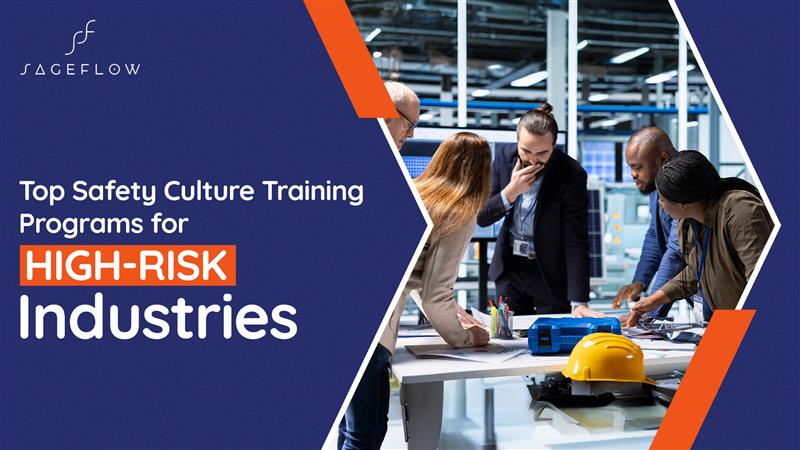Setting up a safety program is straightforward. However, developing a safety culture in a high-risk industry requires diligence and awareness.
Recognising the proactive risks and creating a safety culture is crucial in a high-risk workplace. Such a culture is beyond adhering to regulations and practising the rules.
Statistics by the Occupational Safety and Health Administration (OSHA) indicate that several businesses have experienced severe financial losses due to a lack of safety culture. Others have led to injuries, operational suspension and legal repercussions.
This can be alleviated with structural safety culture training for employees and leaders. While programs and policies can be adhered to, creating a culture demands extensive cooperation across levels.
This comprehensive article will discuss some of the best safety culture training programs and why high-risk industries need them the most.
What Is a Safety Culture and Why Does It Matter?
Before we discuss why a safety culture is essential for industries, let us understand what it is.
A Safety Culture is the outcome of an individual or group effort to set an inherent safety standard in a workplace. It fosters a proactive approach to creating a safety fundamental and contributes to business growth and expansion.
A safety culture is more than a set of rules and policies. It is about the mindset of the workforce, which enables them to tackle safety challenges if and when they arise.
However, a successful safety culture setup demands two-way cooperation and eagerness. The foundation stands on a business and the resources willing to practise a safety culture setup.
Why High-Risk Industries Need Specialised Safety Training?
High-risk industries face endless challenges, and stringent safety policies help protect employees from potential risks. Manufacturing, construction, and healthcare are top industries with high-risk work environments.
Safety culture knowledge and resources are now critical to handling minor and major struggles, which may entail accidents, injuries or even legal hassles.
As a workforce, being aware of safety culture standards has its benefits –
- It reduces severe accidents or turns of events since the resources have the upper hand and can mitigate a critical situation.
- The standard ensures that the Work Health and Safety Act 2020 is met and that company policies comply with the regulations.
- It protects the business from legal backlash since a well-documented safety culture reduces resource liability.
- It enhances reputation and builds a culture of trust and reliability between business owners and employees.
- The fewer challenges and critical conditions lead to fewer compensations and fines, thereby allowing better finances.
A robust safety culture within a workforce is the backbone of safeguarding everyone involved. This is highly beneficial to high-risk industries and ensures seamless and struggle-free operations.
It underlines a people-oriented mindset and sets the benchmark on a broader scale, especially among leaders.
Key Features of Effective Safety Culture Training Programs
Safety culture training is the key to empowering employees and helping them identify and manage potential risks. Everyone in a workplace must be aware of the hazards they are exposed to. Furthermore, they must be mindful of situations that demand following protocols.
Here are the key features of functional safety culture training for high-risk industries –
Safety Policy Awareness
The prime stance is to create awareness among the employees about safety protocols and their role in them. The awareness session educates them on all the regulations and policies and how to act when the situation demands. The process entails orientation programs, safety and health training and emergency drills.
Accountability
An accountability session demonstrates individual commitment to workplace safety. It reiterates the vitality of safety culture training within the organisation and reinstates the roles and responsibilities of authoritative figures.
Involvement
As the saying goes, safety training programs are for the employees, of the employees and by the employees. Therefore, the workforce must be involved for the successful setup and implementation. For instance, if there is a safety committee in a decision-making spot, it must have workforce members and management.
Hazard Identification
A hazard may occur in a high-risk workplace, which is relatively standard. However, what is the condition of the hazard? Is it potent? What is the risk rate?
A training program must enlighten the workforce about hazardous working conditions. They must be able to identify them and secure a mitigation plan. If greater criticality arises, they must be able to assess and report for professional guidance.
Analysis
Whether a minor incident or a severe accident, it is vital to analyse the root concern that will eventually trigger a CAPA or Corrective and Preventive Action.
The safety committee must be within the loop and empower the resources to analyse the data and prevent recurrences.
Proactive Participation
There is no optimum safety culture training program—everything requires A/B testing and continuous improvements. While aware of the existing hazards, resources with specific expertise must possess knowledge of potential hazards and offer additional input towards prevention and protection.
These key features of a safety training program serve as a tool to enable end-to-end safety within the organisation. This is a core component for any high-risk industry and offers a robust solution in danger management.
Top Safety Culture Training Programs for High-Risk Industries
There are varied types of employee safety awareness programs available in the domain. You can pick any training program, depending on the type of industry and relevance –
1. Basic Safety Orientation
A Basic Safety Orientation program equips employees with essential knowledge and awareness of optimal safety standards. Workers can understand coherent policies comprehensively and master the basics of personal protective equipment (PPE) during emergencies.
2. Confined Space Training
Workers working within vessels, pipelines, tanks or other confined spaces must have proper safety training.
A training program helps them recognise confined space struggles and potential hazards. It empowers them with crucial knowledge and protection resources.
3. Core Compliance Training
Core compliance training enables workers to stay ahead of their conscious practices. They can actively participate and foster a sense of optimum regulation and hazard control.
A structural session ensures every employee has the pre-qualified requirements to tackle themselves. Furthermore, it sets the core for an enforced safety culture.
4. NORM/TENORM Training
NORM/TERNORM training is for specialised work zones where workers deal with naturally radioactive substances. Industries in this category include oil mines and water treatment plans, each of which can lead to hazardous working conditions.
Safety culture training reduces workers’ chance of radiation exposure and maintains a healthy work environment.
Beyond these programs, several other popular safety culture programs enable an industry to safeguard its resources. To name a few different programs –
- Lockout /Tag out Training
- Pipeline Safety Training
- Respiratory Protection Training
- Safe Driver Training
Crafting an effective safety culture training program that meets your business’s needs requires effort and commitment. This approach helps a company stand out and protect its employees from danger.
Understanding what your business deals with and what you prioritise regarding safety is vital. These factors help create a tailored training program.
Implementing Safety Culture Training Programs in Your Organisation
Safety culture is paramount in a high-risk industry. While simple rules and regulations work, a culture sets the standard for an optimum work environment.
Offering culture training to the employees and the leaders ensures a structured workspace where safety and protection are supreme. It delivers the much-needed skills and knowledge among the resources to identify workplace threats and practise the essential protocols.
An organisation must understand the value of investing in bespoke safety culture training. They must guarantee that every employee has comprehensive training and can navigate high-risk industry conditions.
At Sageflow, we offer strategic solutions to varied high-risk industries, ensuring their employees are vigilant about challenges. We also provide a comprehensive safety culture training and leadership program, helping you and your workforce stand the test of time.
FAQS (Frequently Asked Questions)
1. How can safety culture be improved in high-risk industries?
In high-risk industries, it is vital to prioritise workplace safety training, enabling resource awareness about challenges. The policies and comprehensive training help them recognise critical situations and seamlessly manage their responsibilities.
2. Why is leadership training essential for a safety culture?
A leader with a strong sense of safety will diligently empower the workforce to develop a safety mindset. They can communicate their ideas, contribute during the bespoke sessions and prioritise safety leadership development at every step.
3. How do I measure the success of safety culture training?
There is no set standard or meter to gauge the effectiveness of safety culture training. Start by tracking their progress and knowledge and taking employee and leader feedback. Monitor the ongoing trends for high-risk industry safety and be open to A/B testing.








